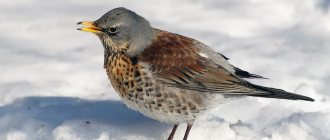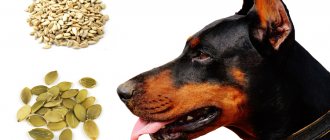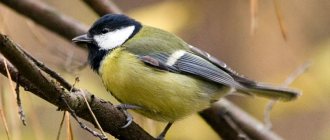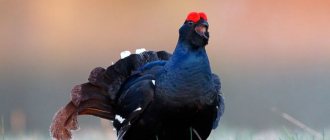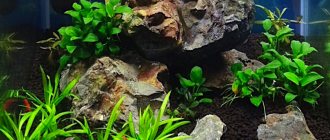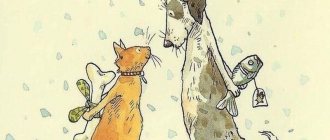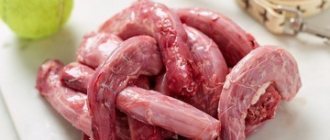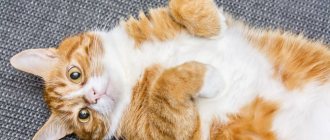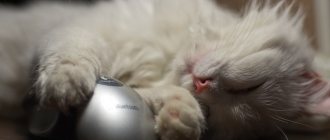General feeding rules
To lure birds to the feeder, you need to understand that they should be fed, not fed.
This is especially true for small forest birds, such as titmice, woodpeckers, nuthatches, and jays. Feeding involves the constant presence of food in the feeder. At the same time, the birds begin to be lazy and no longer fly to get food on their own; they feed exclusively on government grub. As a rule, there is always the same food in the feeders. When a bird regularly eats the same foods, especially those with fat, this has a bad effect on its body. Usually such individuals are easy to recognize. They are larger than others and have ruffled feathers. By the way, this process is associated with maintaining heat when the birds are not feeling well. When they are simply fed, they have to get food on their own the rest of the time. In nature, they feed on insects that hide in tree bark in winter, as well as some seeds. And people eat lard, grain, nuts, etc. And it turns out to be a fairly varied diet. Thus, feeding supports the birds, but also prevents them from losing their tone. Therefore, it is worth accustoming your feathered friends to the fact that you will feed them 1 or 2 times a day. It is worth filling their plate at certain hours. It is better to do this before sunset so that the feathered guests go into the night well-fed. It is not recommended to feed birds systematically. The fact is that they very quickly get used to such a good cause. 4-5 days of regular feeding is enough, and the bird will become a regular guest. And if you go somewhere, then she will waste precious hours, uselessly flying to your house.
Feeders are installed on trees, but in such a way as not to lure street animals: cats, dogs, and at such a height that they do not get to the birdseed. In addition, food can be placed in other ways. Pieces of lard and meat, berries are strung on a rope and hung on the branches. The branches are also watered with animal fat. It freezes and the birds peck at it.
If “cafes” for birds are installed on the street near a private house, then it is better to do this away from the building. Such visitors are very messy and throw food in different directions. Since the feeder contains various types of food, they become breeding grounds for debris, bacteria and parasites. It is necessary to ensure its cleanliness by periodically cleaning it, otherwise the birds risk becoming infected.
All that remains is to figure out when to start feeding the birds. Snow and icy conditions are special indications for this, since under such cover it becomes much more difficult to obtain food. And also the first cold weather, when the amount of food in nature is reduced, and the bird’s need for it increases significantly. It turns out that feeding birds is not an easy task. You can't throw just anything into their feeder.
To learn how to properly feed birds in winter, watch the following video.
First of all, it is important to remember: we are only talking about feeding, so there should be enough food for your feathered charges to eat it at one time.
An enhanced diet is justified only in severe frosts. This may seem cruel, but if you give titmice too much food, they will quickly get used to the “easy” life and lose the ability to look for food on their own.
To set up a bird canteen, it is advisable to find a secluded place located high enough above the ground so that rodents and pets cannot reach it. Schedule feeding at a certain time, and the smart titmouse will quickly learn the daily routine.
Months when tits (and other birds wintering in the city) need feeding:
- from early November to mid-April.
We suggest you familiarize yourself with: Saw for cutting trees
It is important to take into account that the titmouse needs to adhere to a certain “diet”. Prohibited:
- Any bread baked with yeast that causes fermentation in the stomach
- Fried foods, everything salty, spicy, sweet.
- Raw cereals, dairy products, potatoes, cabbage, peas.
The best treats for the yellow-breasted tiny bird would be:
- Any raw seeds: pumpkin, flax, sunflower;
- Dried berries of rowan, hawthorn, cranberry, lingonberry;
- Crushed almonds, peanuts, walnuts (also raw);
- Finely crushed hard-boiled egg, apple slices, unleavened bread.
- And, of course, lard.
Prohibited foods for tits
You cannot feed tits in a feeder:
- Roasted sunflower seeds
. Causes liver problems in birds. - Salty food
. Causes indigestion and stomach problems. - Spoiled products
. Causes indigestion. - Bread
. It swells in the crop and begins to ferment, causing the death of the bird.
Controversial questions often arise about whether it is possible to feed tits with millet, because toxic substances accumulate on the grain shell. In modern conditions, this is rare, but if you are still afraid for the life of the bird, pour boiled water over the millet to wash out the toxins.
You can't feed blue citrus and exotic fruits yet. The birds have not consumed them before and therefore may die due to an allergic reaction.
What should you not feed?
Basic Rules:
- First of all, you should not feed anything salty (lard, seeds, pistachios, chips, crackers). It is difficult for birds to remove excess salt from their bodies because they do not have sweat glands. All the work falls on the kidneys, and they may not be able to withstand the increased load. In addition, some salts are deposited in the joints, which will disrupt the bird's musculoskeletal system and cause it severe pain.
- You should not feed birds anything sweet.
- Roasted seeds and hazelnuts. The danger for tits is fats, the excess of which affects the liver and pancreas, as well as carcinogens from such food.
- You should never feed birds rye (black) bread. It very quickly begins to ferment, often already in the bird’s crop, making it difficult, and in some cases, blocking breathing, since the crop, dilated from gases, presses on the trachea.
- You should also not feed fresh wheat (white) bread. It causes indigestion because it turns into a sticky mass that is difficult to move through the digestive system.
- You should not offer moldy bread or spoiled cereal to tits.
- You cannot feed tits kernels (seeds) from cherry, peach, apricot pits, or almonds. They are rich in hydrocyanic acid and even for humans, their excessive consumption is fraught with poisoning.
- You cannot feed tits with peeled millet. Cleared of filmy shells, it is covered with fine bitter dust, which housewives wash off with hot water before cooking. Old, rancid millet, on the surface of which oxidized fats are present, is especially dangerous.
- Potatoes should not be given to birds. Raw tubers contain the alkaloid solanine, of which a tiny amount is enough to seriously poison a bird. Boiled potatoes can be considered almost pure starch - extremely difficult food for a bird's digestive system.
- The same applies to rice - you should not feed it to birds.
- You should not give tits mushrooms. These organisms actively accumulate heavy and radioactive metals and can carry clostridia spores, which cause botulism.
- No canned food! In addition to the product itself, they contain vinegar, sugar, salt, spices, preservatives and flavorings, which are completely unnecessary in the bird's diet.
- You should not give birds soft and granular food for cats and dogs, especially economy class. They contain soy, yeast, fat and attractants - taste enhancers designed to force the animal to eat food that is unnatural for it.
- Do not feed chicken feed.
And most importantly, you need to remember that you cannot feed tits one day and abandon them the next - the birds will spend a lot of energy and precious time (on a short winter day) visiting an empty feeder.
Then they may not have time to eat their fill by the time it gets dark - and by morning they will freeze and die! You can feed tits only regularly 2-3 times every day.
You should adhere to the main rules for limiting feeding of birds.
- It is strictly forbidden to give birds salty foods: seeds, nuts, lard and meat. Since birds do not have sebaceous glands, salts are removed from their bodies only by the kidneys. With excess salt, these organs will quickly stop working, which can even lead to the death of birds.
- Fried foods (nuts, seeds) are dangerous because during this process the fats change their formula. This harms the liver.
- Brown bread and millet are also prohibited. Millet does not have a shell, for example, like millet, because of this, the grain quickly oxidizes in a humid environment. Harmful bacteria and toxins accumulate on its surface. Black bread is dangerous for birds, as it causes increased fermentation in the intestines, which even leads to volvulus. This is due to its high acidity and humidity. Rye starch is also poorly absorbed in the bird’s body.
- Cherry, apricot, plum kernels, and almonds contain hydrocyanic acid. For birds, even in small quantities it is a toxic substance, so such products are also not allowed in feeders.
- The list of unacceptable poultry products continues with potatoes. In its raw form, it is high in solanine, which is a bird poison. Boiled potatoes contain a lot of starch, which is bad for digestion.
- Canned food is not suitable due to the presence of various additives in them: preservatives, salt, sugar, vinegar and spices. Also, do not put cat or dog food in the feeders. They contain yeast and soy.
We invite you to read: What crops can be grown in the Far East
Allowed foods for tits
The most popular food for tits is seeds. But what else can you feed besides them? Simple solution: buy . The bird will be very happy with the treat.
If you don’t know which cereal to choose, pay attention to the following types:
- millet;
- oats;
- millet;
- wheat;
You can feed tits in the city from animal products:
- eggs;
- grain cottage cheese;
- unsalted lard;
- sausage.
Among the vitamin-rich foods, you can offer them dried fruits and berries.
What do tits eat in the wild?
In the warm season, tits feed on small invertebrates and their larvae, destroying a large number of forest pests.
The basis of their diet consists of butterfly caterpillars, spiders, weevils, beetles, dipterans (flies, mosquitoes, midges - which, by the way, can carry diseases dangerous to humans), bedbugs, and aphids.
Chickadees can even eat cockroaches, grasshoppers and crickets; dragonflies and earwigs, ants and even bees and mites.
In autumn and winter, the role of various plant foods, including European beech and hazel seeds, increases in the diet of tits.
They also pick up grains of rye, corn, wheat, and oats from the fields. In addition, titmice eat the fruits and seeds of pine, spruce, linden, maple, birch, lilac, horse sorrel, burdock, pickles, red elderberry, rowan, serviceberry, blueberry, hemp and sunflower.
Unlike other species of tits, such as the blue tit and the tit, the great tit does not make its own winter reserves, but it skillfully finds and eats food hidden by other birds.
Sometimes the great tit even eats carrion. Great tits often visit bird feeders, so these are the birds we can help most often.
Dangerous products
In severe frosts, birds can die from frostbite or starvation. To help them somehow, you can hang out feeders with food. Although tits are distinguished by their omnivorous nature, they cannot eat everything. More precisely, some products can be dangerous to their lives.
Tits do not know what they can and cannot do. Therefore, keep an eye on the contents of the feeder.
- crackers;
- chips;
- salted nuts;
- seeds;
- salted lard.
This restriction applies not only to tits, but to all birds. Their excretory system cannot cope with the accumulated salt. As a result, the bird is poisoned and dies.
The next taboo for birds is fried food. All kinds of fried seeds or nuts can cause liver disease.
Fresh or brown bread, buns, cookies are dangerous, as they can lead to fermentation in the intestines or volvulus. You should not feed tits with spoiled cereals. All citrus fruits are dangerous.
What birds fly to the feeder?
The main problem for birds in the cold season is not the cold at all, because their feather coat protects them from it. But food helps them maintain a fairly high body temperature, about 40°. The lower the temperature outside, the more heat the bird loses. To maintain it, she needs more food. Moreover, in winter the day is significantly shortened, and at twilight the birds are not able to find food for themselves. Consequently, they need to diligently absorb food during the day, and humans help them with this.
A wide variety of birds can be seen at bird feeders in winter. It all depends on the food that is in them, because each bird prefers its own type of treat. The most frequent visitors to such street canteens are, of course, titmice and sparrows. The common tit is a fairly active bird. She is able to ride the most intricate feeders and even those that sway. Tits love sunflower seeds. From a mixture of seeds, they find just these, and scatter the rest on the ground, which other birds actively use by picking them up.
The common great tit is a very grateful bird. Receiving feeding in winter, in summer she will return the favor and look after your garden. It is known that 1 couple takes 40 fruit trees under their protection. She collects all kinds of pests from them. Birds feed their chicks with them. Surprisingly, she feeds them about 350 times per day. There are other species of tits that fly to bird food in winter. This is a blue tit - a bird with a blue hat, a puffy tit - a small black bird with white additions, a Muscovy - a small tit with a white crown. But these guests are rarer and less active.
The sparrow is another avid visitor to the feeder. These are noisy and impudent birds, the undisputed leaders of feeders, but they also bring invaluable benefits in the fight against parasites. One day the Chinese came to the conclusion that sparrows were stealing large quantities of rice from the fields. They declared the birds national pests and destroyed almost all of them. A few years later, their plantations were overrun by a crowd of pests that caused various diseases, after which the sparrows had to be artificially imported and bred again. As a rule, sparrows live in the city in winter, and fly to the countryside in summer. The presence of these birds indicates the high environmental friendliness of the area. By the way, there are so few of them in London that they are listed in the Red Book.
We invite you to familiarize yourself with: Automatic watering at the dacha, automatic watering system at the dacha
The bullfinch also actively visits the bird canteen. The beautiful red-finned male is known to everyone. Females are less attractive and grayish in color. The nuthatch is an inhabitant of forests and parks, a fast and thrifty bird. After he eats on the spot, he will definitely take a couple of grains with him and hide them in the bark of a tree in reserve. Quite often you can find a woodpecker at the feeder. He loves peanuts and other nuts.
And also among the guests of the feeder in winter the following birds are noticed:
- Robin;
- jay;
- pigeon;
- pika;
- waxwing;
- crow;
- jackdaw;
- magpie.
Proper feeding
Having analyzed in detail what foods should not be given to tits, another question arises: what to feed tits in the feeder in winter?
The best option is raw pumpkin and sunflower seeds. Buckwheat, rice cereals, oatmeal, watermelon, melon, and zucchini seeds are also suitable.
In addition to seeds, tits can be fed unsalted lard, butter, dried bread crumbs, walnuts or even small pieces of meat.
If you are caring for a tit at home, then you can feed it with small portions of cottage cheese, a hard-boiled egg, grated on a coarse grater, and small slices of apple.
You can hang thin branches of fruit trees near the feeder. As a calcium supplement, finely crushed chicken egg shells are poured into the feeder.
Tits should be fed no more than twice a day, in small portions. After all, birds may forget how to look for food for themselves. Therefore, do not overdo it, as a large amount of food in the feeder can harm the birds.
What can you put in?
Bird food is varied. Most often, all kinds of cereals are poured into the feeders. It is permissible to give birds the following grains:
- rice;
- wheat;
- oats;
- oatmeal;
- pearl barley;
- rolled oats (flakes only);
- corn;
- millet.
The cereal can be poured raw, boiled until tender or until half cooked. You can also make an assortment by mixing several varieties. To be sure that all the ingredients are chosen correctly and will not cause harm, purchase special mixtures for birds in animal stores. Sunflower seeds are an essential component of complementary food for birds. Many birds love them. These seeds are high in fat and therefore high in calories, making them a good source of energy. In addition to sunflower seeds, you can put pumpkin and watermelon seeds in the feeders. They must first be crushed.
Seeds of other plants are also suitable for feeding birds. But they should be prepared in advance. So, in order to feed the birds with quinoa seeds, the plants are collected, tied into small bouquets and stored until winter. In cold weather, they are placed in the ground or snow, and everyone can enjoy the treat. Ash and maple seeds are also suitable for birds. In the fall they are collected and stored, and in the winter they fill feeders. Birds also do not disdain the seeds of plants such as nettle, burdock, and horse sorrel. Many people prefer acorns and all kinds of nuts: peanuts, hazelnuts. Particular preference is given to hawthorn and rowan. These berries are collected and dried during the season.
To increase the calorie content and energy value of complementary foods, birds are offered lard and meat. They are used raw. You can also use fat: beef, chicken, pork, lamb and horse meat. It is mixed with cereal and you get a pretty good dish loved by birds. They also love finely chopped bacon skins. But fats need to be used in doses, because their excess can lead to deterioration of the liver in birds.
What else they put in the bird feeder is bread, but exclusively white. Black varieties are strictly contraindicated. It can be crumbled or used as an ingredient to make bird pie. To do this, take bread crumbs and sunflower seeds, fill them with oil and freeze them, and then hang them with a rope. Crumbs of white bread are also mixed with low-fat cottage cheese. It is allowed to give birds boiled eggs and crushed eggshells. Place the butter in a piece directly into the feeder.
It is worth considering the following mandatory requirements for bird feed:
- do not add salt;
- do not fry;
- do not add seasonings and spices.
Below is a table showing the preferred food for the most frequent visitors to the poultry canteen.
Tags: feed, can, pearl barley, tit
About the author: admin4ik
« Previous entry
Features of the diet of tits
When they start feeding the birds, the question arises as to what the tits eat. The diet includes:
- Vegetable feed
– cereals. Oats, pearl barley, and rolled oats are the basis of bird nutrition. Sunflower seeds are also used. - Animal feed
. Insect eggs, lard, meat products, cottage cheese (as a source of protein). - Vitamin feed
. You can beautifully feed tits in a feeder using fruits and berries (dried and fresh, strung on a thread).
